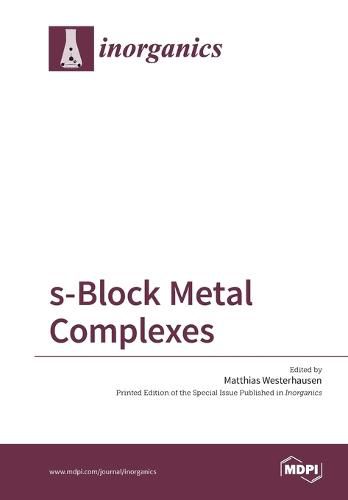Readings Newsletter
Become a Readings Member to make your shopping experience even easier.
Sign in or sign up for free!
You’re not far away from qualifying for FREE standard shipping within Australia
You’ve qualified for FREE standard shipping within Australia
The cart is loading…






This title is printed to order. This book may have been self-published. If so, we cannot guarantee the quality of the content. In the main most books will have gone through the editing process however some may not. We therefore suggest that you be aware of this before ordering this book. If in doubt check either the author or publisher’s details as we are unable to accept any returns unless they are faulty. Please contact us if you have any questions.
Dear Colleagues,
The coordination chemistry of the s-block metals spans diverse fields, ranging from shielded coordination compounds over hydride to organometallic complexes for diverse applications. New developments pertain, not only to the lithium and magnesium chemistry with inspiring examples, such as heterobimetallic or heteroleptic complexes with special reactivity patterns, but the heavy s-block metals have progressively gained attention in various fields. Subvalent magnesium(I) derivatives are increasingly being used for reduction reactions, turbo-Grignard reagents show enhanced reactivity and tolerance toward functional groups, hydrides act as hydrogen storage materials, heavy Grignard reagents are available by straight forward procedures–just to name a few examples. Quantum chemical calculations deal with unique bonding situations and the relevance of d-orbital participation has been discussed to understand structure-reactivity relationships. Especially the complexes of the heavy alkaline earth metals are catalytically active in diverse reactions, promoting hydrofunctionalization reactions and Lewis acid catalysis. This Special Issue aims to highlight the structural and chemical diversity of s-block metal complexes, as well as the broad field of applications.
Prof. Dr. Matthias Westerhausen
Guest Editor
$9.00 standard shipping within Australia
FREE standard shipping within Australia for orders over $100.00
Express & International shipping calculated at checkout
This title is printed to order. This book may have been self-published. If so, we cannot guarantee the quality of the content. In the main most books will have gone through the editing process however some may not. We therefore suggest that you be aware of this before ordering this book. If in doubt check either the author or publisher’s details as we are unable to accept any returns unless they are faulty. Please contact us if you have any questions.
Dear Colleagues,
The coordination chemistry of the s-block metals spans diverse fields, ranging from shielded coordination compounds over hydride to organometallic complexes for diverse applications. New developments pertain, not only to the lithium and magnesium chemistry with inspiring examples, such as heterobimetallic or heteroleptic complexes with special reactivity patterns, but the heavy s-block metals have progressively gained attention in various fields. Subvalent magnesium(I) derivatives are increasingly being used for reduction reactions, turbo-Grignard reagents show enhanced reactivity and tolerance toward functional groups, hydrides act as hydrogen storage materials, heavy Grignard reagents are available by straight forward procedures–just to name a few examples. Quantum chemical calculations deal with unique bonding situations and the relevance of d-orbital participation has been discussed to understand structure-reactivity relationships. Especially the complexes of the heavy alkaline earth metals are catalytically active in diverse reactions, promoting hydrofunctionalization reactions and Lewis acid catalysis. This Special Issue aims to highlight the structural and chemical diversity of s-block metal complexes, as well as the broad field of applications.
Prof. Dr. Matthias Westerhausen
Guest Editor